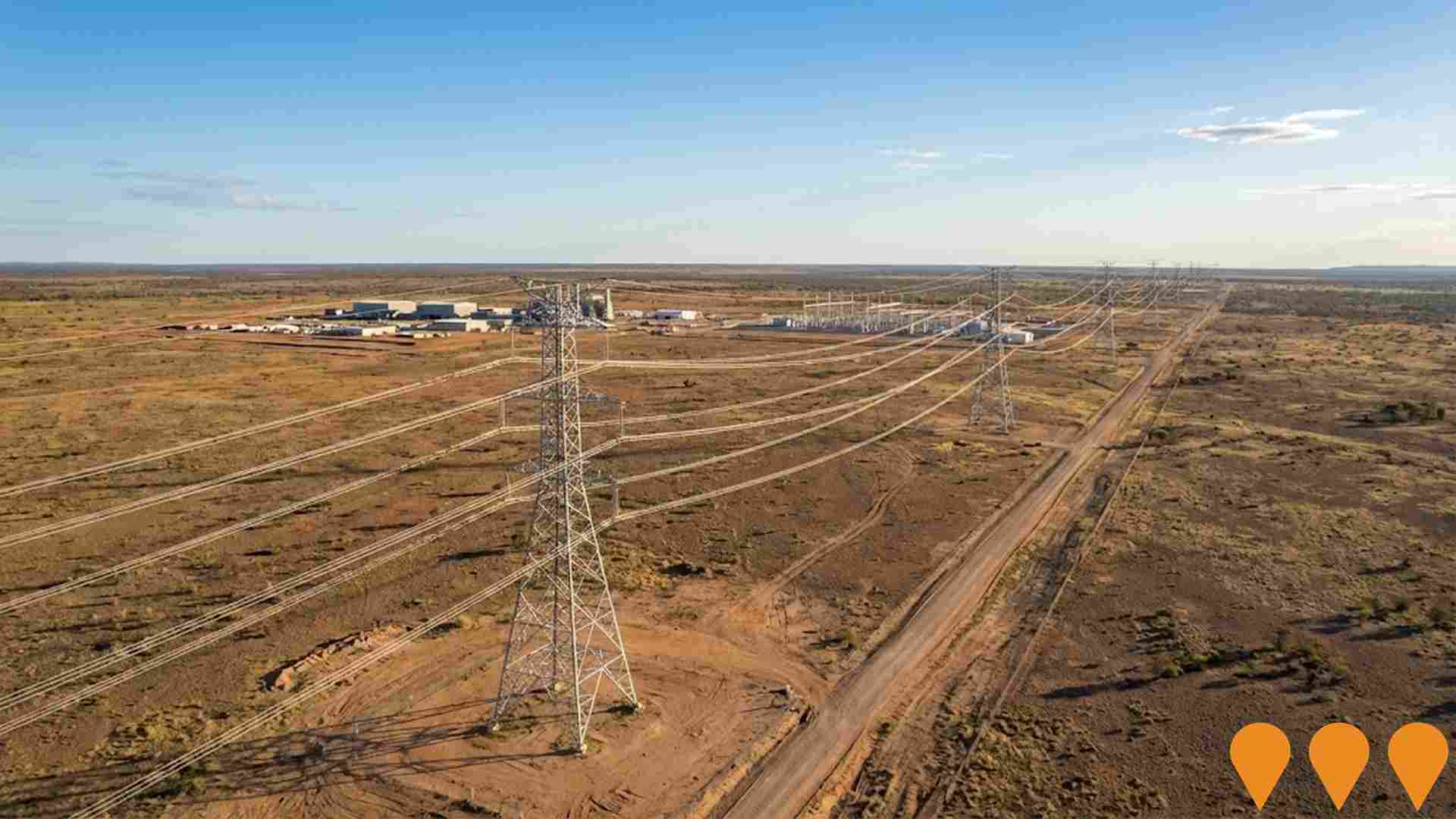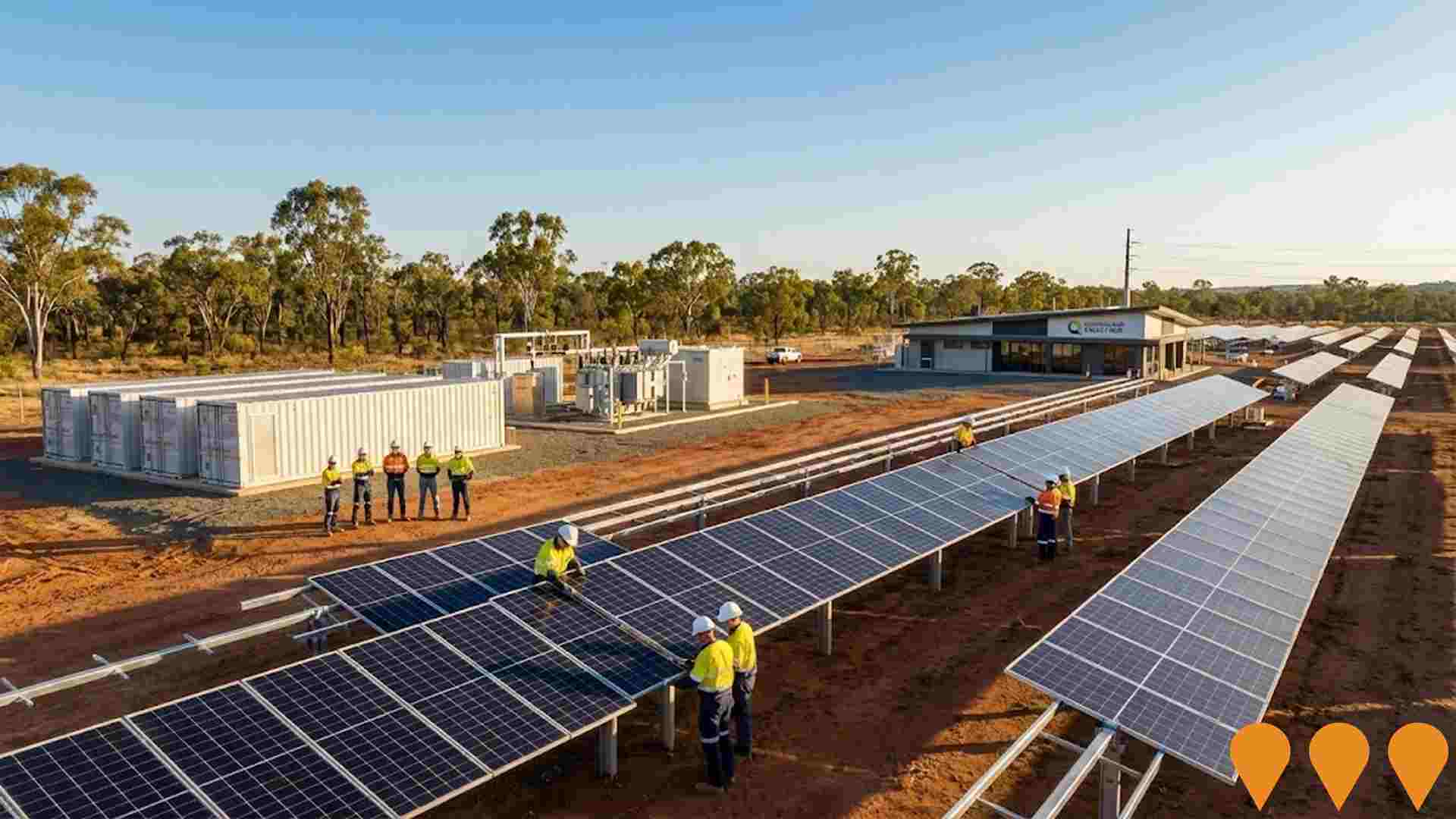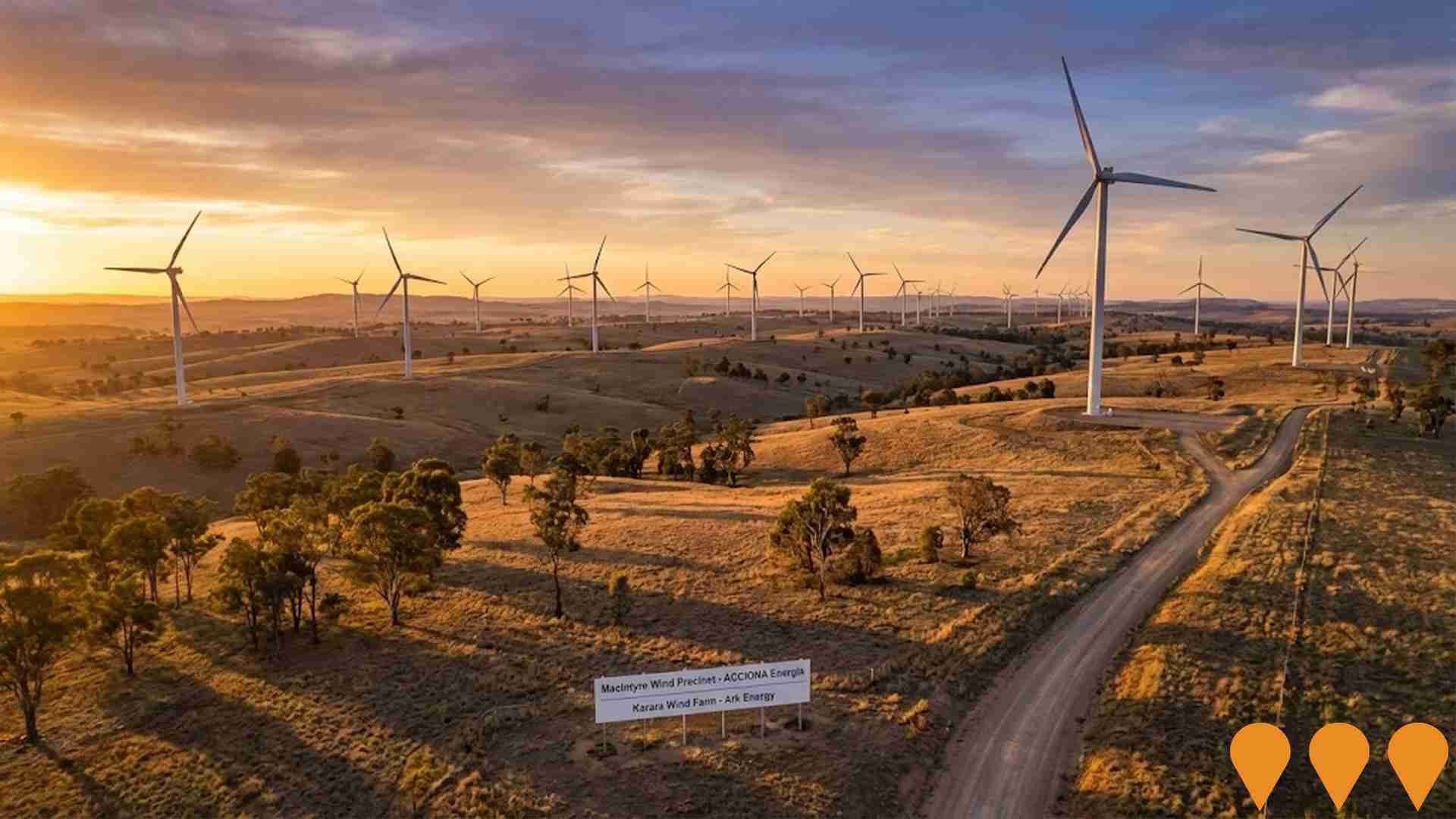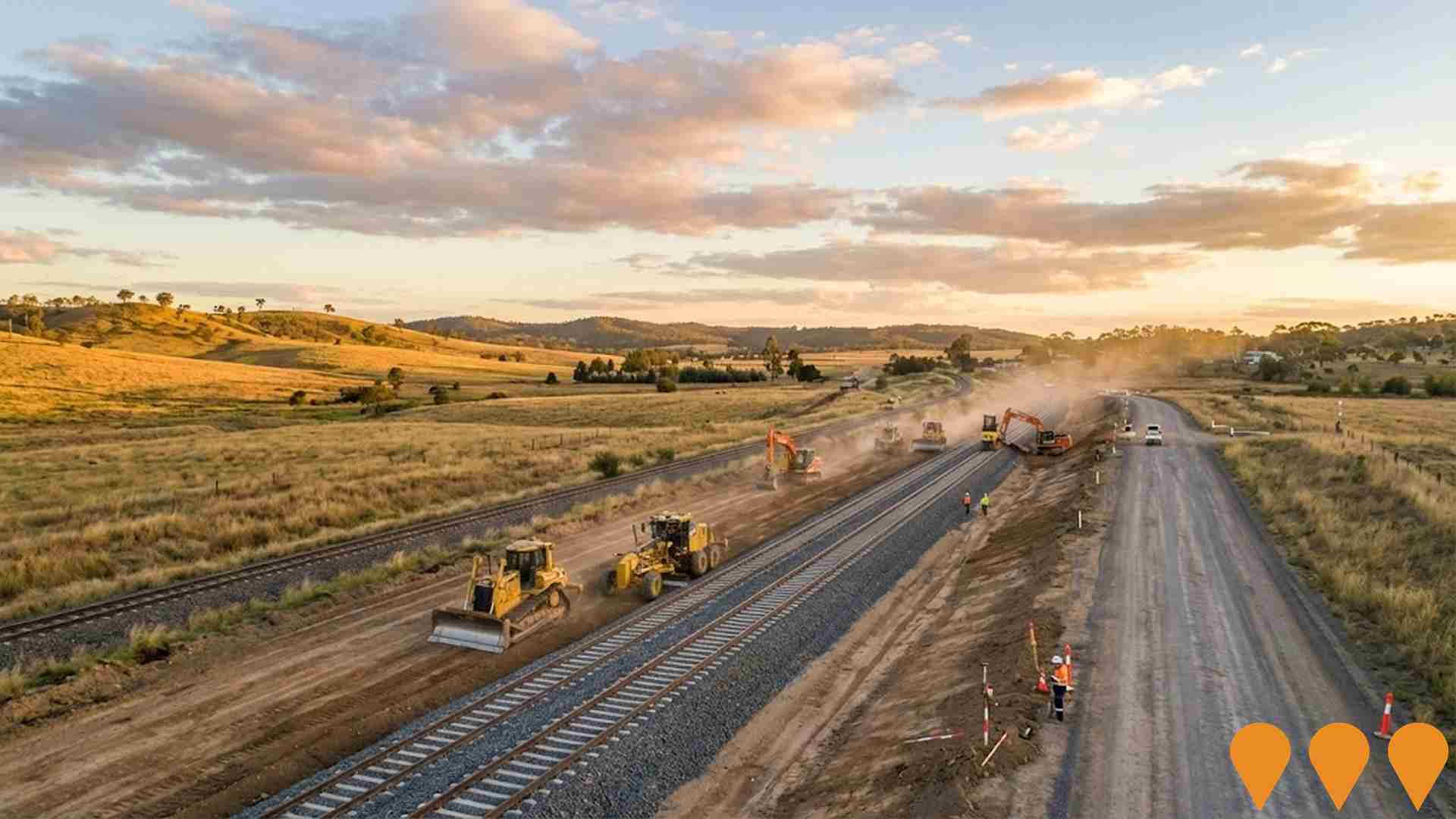Chart Color Schemes
est. as @ -- *
ABS ERP | -- people | --
2021 Census | -- people
Sales Activity
Curious about local property values? Filter the chart to assess the volume and appreciation (including resales) trends and regional comparisons, or scroll to the map below view this information at an individual property level.
Find a Recent Sale
Sales Detail
Population
Stanthorpe has shown very soft population growth performance across periods assessed by AreaSearch
Stanthorpe's population was approximately 5,461 as of Aug 2025. This figure represents an increase of 175 people since the 2021 Census, which reported a population of 5,286 people. The growth is inferred from ABS data showing an estimated resident population of 5,455 in June 2024 and an additional 16 validated new addresses since the Census date. This results in a density ratio of 162 persons per square kilometer. Stanthorpe's 3.3% growth since census compares favorably with its SA4 region (5.1%), indicating strong fundamentals for population growth. Interstate migration contributed approximately 54.9% of overall population gains during recent periods.
AreaSearch uses ABS/Geoscience Australia projections for each SA2 area, released in 2024 with a base year of 2022. For areas not covered by this data and years post-2032, Queensland State Government's SA2 area projections are adopted, released in 2023 based on 2021 data. However, these state projections do not provide age category splits, so AreaSearch applies proportional growth weightings using ABS Greater Capital Region projections released in 2023, based on 2022 data. According to demographic trends, Australia's regional areas are expected to have lower quartile growth, with Stanthorpe projected to increase by 17 persons to reach a total population of approximately 5,486 by 2041, reflecting an overall increase of about 0.2% over the 17-year period.
Frequently Asked Questions - Population
Development
AreaSearch assessment of residential development drivers sees a low level of activity in Stanthorpe, placing the area among the bottom 25% of areas assessed nationally
Stanthorpe averaged approximately 13 new dwelling approvals annually over the past five financial years, totalling 66 homes. As of FY26, 4 approvals have been recorded. The average population increase per year for each dwelling built in Stanthorpe between FY21 and FY25 was 0.6 people. This indicates that supply is meeting or exceeding demand, offering greater buyer choice while supporting potential population growth beyond projections.
The average value of new homes being constructed is $433,000, which is below regional levels, suggesting more affordable housing options for buyers. In FY26, there have been $8.5 million in commercial approvals, indicating limited focus on commercial development. Compared to the Rest of Qld, Stanthorpe has around two-thirds the rate of new dwelling approvals per person and ranks among the 40th percentile nationally, resulting in relatively constrained buyer choice and supporting interest in existing properties. This is also below the national average, suggesting the area's established nature and potential planning limitations.
New development consists of 80% detached dwellings and 20% attached dwellings, preserving Stanthorpe's low-density character and attracting space-seeking buyers. The estimated population per dwelling approval is 428 people, reflecting its quiet, low-activity development environment. Future projections indicate Stanthorpe adding 11 residents by 2041. At current development rates, new housing supply should comfortably meet demand, providing good conditions for buyers and potentially supporting growth beyond current population projections.
Frequently Asked Questions - Development
Infrastructure
Stanthorpe has limited levels of nearby infrastructure activity, ranking in the 15thth percentile nationally
Changes to local infrastructure significantly impact an area's performance. AreaSearch identified five projects that could affect this region. Notable projects are 14 Wallangarra Road Student Accommodation, The Avenues Stanthorpe, Stanthorpe Wastewater Treatment Plant Upgrade, and Stanthorpe Streetscape Project. Below is a list of the most relevant projects.
Professional plan users can use the search below to filter and access additional projects.
INFRASTRUCTURE SEARCH
 Denotes AI-based impression for illustrative purposes only, not to be taken as definitive under any circumstances. Please follow links and conduct other investigations from the project's source for actual imagery. Developers and project owners wishing us to use original imagery please Contact Us and we will do so.
Denotes AI-based impression for illustrative purposes only, not to be taken as definitive under any circumstances. Please follow links and conduct other investigations from the project's source for actual imagery. Developers and project owners wishing us to use original imagery please Contact Us and we will do so.
Frequently Asked Questions - Infrastructure
Queensland Energy Roadmap Infrastructure
The Queensland Energy Roadmap 2025 is the State Government's strategic plan to deliver affordable, reliable, and sustainable energy. Replaces the former Energy and Jobs Plan, focusing on extending the life of state-owned coal assets, a $1.6 billion Electricity Maintenance Guarantee, and the $400 million Queensland Energy Investment Fund. Key infrastructure includes the CopperString transmission line and new gas-fired generation, while the Pioneer-Burdekin Pumped Hydro project has been cancelled in favor of smaller storage options.

Queensland Energy and Jobs Plan
The Queensland Energy and Jobs Plan, initially a comprehensive plan for renewable energy and job creation, has been superseded by the Queensland Energy Roadmap 2025 by the new government (October 2025). The Roadmap focuses on energy affordability, reliability, and sustainability by leveraging existing coal and gas assets, increasing private sector investment in renewables and storage (targeting 6.8 GW of wind/solar and 3.8 GW of storage by 2030), and developing a new Regional Energy Hubs framework to replace Renewable Energy Zones. The initial $62 billion investment pipeline is now primarily focused on implementing the new Roadmap's priorities, including an estimated $26 billion in reduced energy system costs compared to the previous plan. The foundational legislation is the Energy Roadmap Amendment Bill 2025, which is currently before Parliament and expected to pass by December 2025, formally repealing the previous renewable energy targets. Key infrastructure projects like CopperString's Eastern Link are still progressing. The overall project is in the planning and legislative amendment phase under the new policy.

Inland Rail - Queensland Sections
The Queensland sections of Inland Rail form part of the 1,700km Melbourne-to-Brisbane freight railway. Key active segments in Queensland include Calvert to Kagaru (C2K), Helidon to Calvert (H2C), Gowrie to Kagaru (G2K overall), Border to Gowrie (B2G via NSW), and the connection at Ebenezer. The former Kagaru to Acacia Ridge and Bromelton section has been cancelled; the line now connects to the interstate network at Kagaru. Multiple sections are now under construction or in detailed design and early works as of late 2025.

Building Future Hospitals Program
Queensland's flagship hospital infrastructure program delivering over 2,600 new and refurbished public hospital beds by 2031-32. Includes major expansions at Ipswich Hospital (Stage 2), Logan Hospital, Princess Alexandra Hospital, Townsville University Hospital, Gold Coast University Hospital and multiple new satellite hospitals and community health centres.

MacIntyre Wind Precinct
Australia's largest wind energy precinct, located west of Warwick in Queensland's Southern Downs region. The precinct includes the 923 MW MacIntyre Wind Farm (162 turbines, ACCIONA Energia) which achieved first power in November 2024 and is on track for full commercial operations by late 2025, and the 103 MW Karara Wind Farm (Ark Energy). A 400 MW / 800 MWh battery energy storage system (Karara BESS) has development approval and is expected to commence construction in 2025. The proposed 1,000 MW Herries Range Wind Farm remains in early planning. Total precinct capacity exceeds 2 GW when fully built.

Emu Swamp Dam Project (Granite Belt Irrigation Project)
A proposed 12,074 ML irrigation dam and water-supply scheme on the Severn River, 15km south-west of Stanthorpe. It includes the dam, a pipeline distribution network, and irrigation channels for the Granite Belt region. The original Environmental Impact Statement (EIS) evaluation report lapsed in April 2023, and the project is currently being re-evaluated as part of the Queensland Government's Southern and Darling Downs Regional Water Assessment (RWA) due to increased cost estimates.

Inland Rail - NSW/Queensland Border to Gowrie (B2G)
The Border to Gowrie (B2G) section of Inland Rail is a ~217km segment (149km new dual-gauge track and 68km upgraded existing track) connecting the NSW/QLD border near Yelarbon (18km southeast of Goondiwindi) to Gowrie Junction northwest of Toowoomba. Part of the Melbourne-to-Brisbane Inland Rail freight corridor. As of November 2025, the project is in the approvals phase following closure of public consultation on the revised draft EIS (12 May - 4 August 2025). Inland Rail is preparing a response to submissions for the Queensland Coordinator-General. Subject to approvals, major construction expected to commence by 2029, taking ~4 years.

Stanthorpe Wastewater Treatment Plant Upgrade
Major upgrade of the aging Stanthorpe Wastewater Treatment Plant which has reached end of life. The project involves full design and renewal of the treatment facility using the latest technology to ensure capacity for growth, improved reliability, and compliance with changing environmental standards. Concept design has been completed and detailed design is underway before construction contractors are engaged.

Employment
Employment conditions in Stanthorpe remain below the national average according to AreaSearch analysis
Stanthorpe's workforce is balanced across white and blue collar jobs, with varied sector representation. The unemployment rate was 4.7% in the past year (June 2025), with an estimated employment growth of 4.0%.
As of June 2025, 2,285 residents are employed, while the unemployment rate is 0.8% higher than Rest of Qld's rate of 3.9%. Workforce participation in Stanthorpe is lower at 47.0%, compared to Rest of Qld's 59.1%. Dominant employment sectors include health care & social assistance, agriculture, forestry & fishing, and retail trade. Agriculture, forestry & fishing shows notable concentration with employment levels at 3.0 times the regional average.
Conversely, mining has lower representation at 0.6% versus the regional average of 3.6%. Many residents commute elsewhere for work based on Census data. In the past year, employment increased by 4.0%, while labour force grew by 5.7%, leading to a rise in unemployment rate by 1.6 percentage points. Rest of Qld experienced employment growth of 1.8% and labour force growth of 2.0%, with a 0.2 percentage point rise in unemployment rate. National employment forecasts from Jobs and Skills Australia (May 2025) project national employment growth of 6.6% over five years and 13.7% over ten years, but growth rates vary by industry sector. Applying these projections to Stanthorpe's employment mix suggests local growth of approximately 6.0%% over five years and 12.8% over ten years.
Frequently Asked Questions - Employment
Income
Income metrics place the area in the bottom 10% of locations nationally according to AreaSearch analysis
AreaSearch's latest postcode level ATO data for financial year 2022 shows that income in Stanthorpe is below the national average. The median income is $38,665 and the average income stands at $47,217. In contrast, Rest of Qld has a median income of $50,780 and an average income of $64,844. Based on Wage Price Index growth of 13.99% since financial year 2022, current estimates would be approximately $44,074 (median) and $53,823 (average) as of September 2025. From the 2021 Census, household, family and personal incomes in Stanthorpe all fall between the 3rd and 8th percentiles nationally. Distribution data shows that 33.2% of the population (1,813 individuals) fall within the $400 - 799 income range, unlike metropolitan regions where 31.7% fall within the $1,500 - 2,999 range. The prevalence of lower-income residents indicates constrained household budgets across much of the area. After housing costs, 85.1% of income remains, ranking at only the 5th percentile nationally.
Frequently Asked Questions - Income
Housing
Stanthorpe is characterized by a predominantly suburban housing profile, with above-average rates of outright home ownership
Stanthorpe's dwelling structure, as per the latest Census, consisted of 88.4% houses and 11.6% other dwellings (semi-detached, apartments, 'other' dwellings). This compares to Non-Metro Qld's 92.3% houses and 7.6% other dwellings. Home ownership in Stanthorpe was at 44.8%, with the rest being mortgaged (23.8%) or rented (31.3%). The median monthly mortgage repayment was $1,200, lower than Non-Metro Qld's average of $1,300. The median weekly rent in Stanthorpe was $250, compared to Non-Metro Qld's $255. Nationally, Stanthorpe's mortgage repayments were significantly lower at $1,200 than the Australian average of $1,863, and rents were substantially below the national figure of $375.
Frequently Asked Questions - Housing
Household Composition
Stanthorpe features high concentrations of lone person households, with a lower-than-average median household size
Family households constitute 61.1% of all households, including 18.6% couples with children, 31.7% couples without children, and 9.8% single parent families. Non-family households account for the remaining 38.9%, with lone person households at 36.2% and group households comprising 2.6%. The median household size is 2.1 people, which is smaller than the Rest of Qld average of 2.3.
Frequently Asked Questions - Households
Local Schools & Education
Stanthorpe faces educational challenges, with performance metrics placing it in the bottom quartile of areas assessed nationally
The area faces educational challenges, with university qualification rates at 16.3%, significantly below the Australian average of 30.4%. This represents both a challenge and an opportunity for targeted educational initiatives. Bachelor degrees lead at 12.3%, followed by postgraduate qualifications at 2.5% and graduate diplomas at 1.5%. Trade and technical skills are prominent, with 37.2% of residents aged 15+ holding vocational credentials - advanced diplomas at 9.2% and certificates at 28.0%.
Educational participation is high, with 25.1% of residents currently enrolled in formal education. This includes 10.3% in primary education, 8.7% in secondary education, and 1.9% pursuing tertiary education. Stanthorpe's 3 schools have a combined enrollment reaching 1,318 students while the area demonstrates typical Australian school conditions (ICSEA: 971) with balanced educational opportunities. The educational mix includes 1 primary, 1 secondary, and 1 K-12 school. The area functions as an education hub with 24.1 school places per 100 residents - significantly above the regional average of 14.1 - attracting students from surrounding communities.
Frequently Asked Questions - Education
Schools Detail
Nearby Services & Amenities
Transport
Transport servicing is very low compared to other areas nationally based on assessment of service frequency, route connectivity and accessibility
Stanthorpe has seven active public transport stops operating currently. These stops are served by a mix of buses running along two routes, offering a total of 20 weekly passenger trips combined. The accessibility to these services is considered limited, with residents generally residing an average distance of 977 meters from the nearest stop.
On average, across all routes, service frequency stands at approximately two trips per day, which translates to about two weekly trips per individual stop.
Frequently Asked Questions - Transport
Transport Stops Detail
Health
Health performance in Stanthorpe is a key challenge with a range of health conditions having marked impacts on both younger and older age cohorts
Stanthorpe faces significant health challenges, with various conditions affecting both younger and older age groups. Private health cover is low at approximately 46%, covering around 2,512 people, compared to the national average of 55.3%.
The most prevalent medical conditions are arthritis (affecting 12.4% of residents) and mental health issues (8.9%). Around 59.6% of residents report no medical ailments, slightly lower than the Rest of Qld's 62.0%. Stanthorpe has a higher proportion of residents aged 65 and over, at 32.4% (1,771 people), compared to Rest of Qld's 27.0%.
Frequently Asked Questions - Health
Cultural Diversity
Stanthorpe ranks below the Australian average when compared to other local markets across a number of language and cultural background related metrics
Stanthorpe, when assessed for cultural diversity, showed a lower average with 88.3% of its residents being Australian citizens, 83.2% born in Australia, and 90.4% speaking English only at home. Christianity was the predominant religion in Stanthorpe, accounting for 62.6%, which is slightly below the Rest of Qld's figure of 63.9%. The top three ancestry groups in Stanthorpe were English (30.0%), Australian (27.2%), and Irish (8.5%).
Notably, Italian ancestry was overrepresented at 8.2% compared to the regional average of 2.8%, while German ancestry stood at 4.4% versus a regional figure of 5.6%. Korean ancestry, however, was slightly higher than the regional average, with Stanthorpe reporting 0.4% compared to 0.1%.
Frequently Asked Questions - Diversity
Age
Stanthorpe ranks among the oldest 10% of areas nationwide
Stanthorpe's median age is 50 years, which is significantly older than Rest of Qld's 41 years and higher than the Australian median of 38 years. The age profile shows that 65-74 year-olds are particularly prominent at 16.6%, while the 35-44 group is smaller at 9.8% compared to Rest of Qld. This concentration of 65-74 year-olds is well above the national average of 9.4%. Post-2021 Census data shows that the 15-24 age group grew from 8.9% to 11.1%, and the 75-84 cohort increased from 10.5% to 11.5%. Conversely, the 5-14 cohort declined from 11.6% to 9.4%, and the 45-54 group dropped from 11.3% to 10.2%. Demographic modeling suggests that Stanthorpe's age profile will evolve significantly by 2041, with the 85+ age cohort projected to expand by 140 people (60%), from 232 to 373. Senior residents aged 65 and above will drive 68% of population growth, highlighting demographic aging trends. Meanwhile, both the 65-74 and 45-54 age groups are expected to see reduced numbers.




